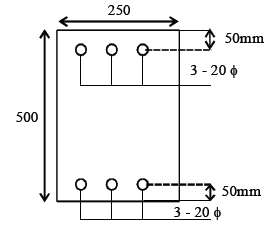Test: RCC - Civil Engineering (CE) MCQ
25 Questions MCQ Test GATE Civil Engineering (CE) 2025 Mock Test Series - Test: RCC
Assuming the concrete is uncracked, compute Bending stress in extreme fibres of Beam for Bending moment 5kN-m & axial load 200 kN use M25, Fe45

Assuming the concrete is uncracked, compute Bending stress in extreme fibres of Beam for Bending moment 5kN-m & axial load 200 kN use M25, Fe45

In above question, determine cracking moment in kNm.
Slab supported on wall on two opposite edges as given in figure. Thickness of wall is 250mm & thickness of slab is 175mm. Consider M20, Fe415 & effective cover 25mm. Find moment of Resistance of slab per meter width using LSM

A simply supported beam having effective length 8m subjected to a live load 6 kN/m the size of Beam is given below. Width of support is 300mm. Use M20/Fe415 use LSM. Find spacing for 2-legged 8mm φ - vertical stirrups. Use τc = 0.20 N/mm2
In the previous question calculate bend stress. (in N/mm2)
(Important - Enter only the numerical value in the answer)
For a pretensioned beam, Young’s modulus of steel and concrete are 200 GPa and 35.35 GPa, respectively If the ultimate shrinkage strain and ultimate creep coefficient are 200 microns and 1.6 respectively, what is the level of sustained stress in concrete at the level of steel if the loss due to creep is three times the loss due to
shrinkage?
In a post tensioned pre-stressed concrete Beam. The end block zone is in between the end of the beam
and the section where
Find ultimate axial load carrying capacity of circular column having diameter 500mm. Consider clear cover 50mm. Column having 12Nos-20mm φ longitudinal Reinforcement & 8mm φ spiral Reinforcement.
Use M20/Fe415.
A simply supported post-tensioned prestressed concrete beam of span L is prestressed by a straight tendon
at a uniform eccentricity ‘e’ below the centroidal axis. If the magnitude of prestressing force is P and
flexural rigidity of beam is EI, maximum deflection of the beam is
For maximum hogging bending moment at suppot in a continuous RC beam, live load should be placed on
A box girder is subjected to loads as shown in the figure below. The critical section for shear in the bottom slab will occur at
An isolated T-beam is used as a walkway. The beam is simply supported with an effective span of 6 m. The effective width of flange, for the cross-section shown in the figure is
Shrinkage deflection in case of rectangular beams and slabs can be eliminated by putting
The limits of percentage ‘p’ of the longitudinal reinforcement in a column is
A reinforced cantilever beam of span 7m, has a cross-sectional area of 250 mm X 500 mm (effective)
if checked for lateral stability and deflection, the beam will
In an RCC beam of breadth ‘b’ and overall depth exceeding 750 mm, side face reinforcement required and allowable area of maximum tension reinforcement shall be respectively.
Effective cover – 40 mm
Effective depth – 560 mm
Width of beam – 300 mm
Grade of concrete – M20
Grade of Steel – Fe 415
Take m = 13, σcbc = 7 N/m2, σst = 230 N/mm2.
Find moment of resistance of beam using working stress method __________
(Important - Enter only the numerical value in the answer)
The equivalent bending moment for the beam having loading as follows is
BM = 300 kNm
SF = 120 kN
Torsional moment = 72 kNm
Use M 25/ Fe 415,
b = 400 mm,
d = 450 mm.
Effective cover = 50 mm
Linked Question 21 & 22
In the design of beams for unit limit state of collapse in flexure (as per IS : 456 : 2000), let the maximum strain in concrete be limited to 0.0025 (in place of 0.0035). For this situation, consider a rectangular beam section with breadth as 300 mm, effective depth as 450 mm, Area of tension steel as 1500 mm2, and characteristic
strength of concrete and steel as 30 Mpa and 250 Mpa respectively.
Q. The depth of neutral axis for the balanced failure is
At the limiting state of collapse in flexure the force acting on the compression zone of the section is
If characteristic compressive strength of concrete fck is defined as strength below which not more than 95% of the test result are expected to fall, the expression of fck in term of mean strength fm and standard deviation σ would be
What is the minimum percentage of steel required in tension reinforcement in a beam where Fe 415 steel is used?
Find Area of tensile steel for following section. If required consider section as doubly
Reinforced
If span of beam is 5m & external load is 20 kN/m. Use LSM. Beam is simply supported
|
31 docs|280 tests
|




















